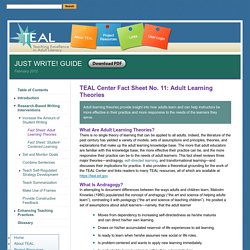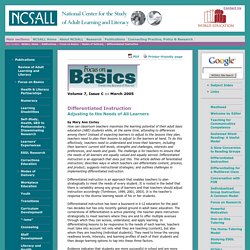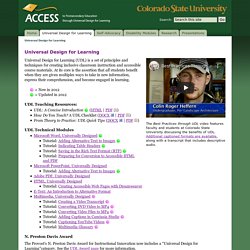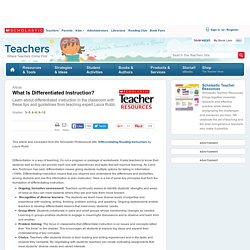

TEAL Center Fact Sheet No. 11: Adult Learning Theories. Adult learning theories provide insight into how adults learn and can help instructors be more effective in their practice and more responsive to the needs of the learners they serve.

What Are Adult Learning Theories? There is no single theory of learning that can be applied to all adults. Indeed, the literature of the past century has yielded a variety of models, sets of assumptions and principles, theories, and explanations that make up the adult learning knowledge base. The more that adult educators are familiar with this knowledge base, the more effective their practice can be, and the more responsive their practice can be to the needs of adult learners. This fact sheet reviews three major theories—andragogy, self-directed learning, and transformational learning—and discusses their implications for practice. What Is Andragogy? Moves from dependency to increasing self-directedness as he/she matures and can direct his/her own learning. Andragogy is not without criticism. References. "Raising the Bar" - Differentiated Learning.
UDL Lesson Plan Instructions. Instructions The Dilemma How can I teach grade-level standards to all students in general education, regardless of exceptionality?

How do I assess and grade them? How do I keep students who already know the skill challenged? How do I follow President Bush’s mandate and leave no child behind without watering down the curriculum? How can I maintain high expectations for all students? The Answer Make learning accessible for all students by universal design for learning. Using the Lesson Plan for Universal Design Keep in mind! The UDL lesson plan is NOT a daily lesson plan. Universal Design for Learning (UDL) Examples 6.2. Differentiated Instruction. By Mary Ann Corley How can classroom teachers maximize the learning potential of their adult basic education (ABE) students while, at the same time, attending to differences among them?

Instead of expecting learners to adjust to the lessons they plan, teachers need to plan their lessons to adjust to the learners at hand. To do this effectively, teachers need to understand and know their learners, including their learners’ current skill levels, strengths and challenges, interests and preferences, and needs and goals. The challenge is for teachers to ensure that the needs of all learners are equally valued and equally served. Differentiated instruction is an approach that does just this. This article defines dif ferentiated instruction; describes ways in which teachers can differentiate content, process, and product; suggests instructional strategies; and outlines challenges in implementing differentiated instruction. Learning ProfileLearning profile refers to how a student learns best. Universal Design for Learning - The ACCESS Project - Colorado State University. The Best Practices through UDL video features faculty and students at Colorado State University discussing the benefits of UDL.

Additional captioned formats are available, along with a transcript that includes descriptive audio. Universal Design for Learning (UDL) is a set of principles and techniques for creating inclusive classroom instruction and accessible course materials. At its core is the assertion that all students benefit when they are given multiples ways to take in new information, express their comprehension, and become engaged in learning. = New in 2012 = Updated in 2012 UDL Teaching Resources: UDL: A Concise Introduction (HTML | PDF) How Do You Teach? UDL Technical Modules N. The Provost’s N. Overview. The Center for Universal Design in Education (CUDE) develops and collects resources to help educators apply universal design to all aspects of the educational experience: instructionstudent servicesinformation technology, andphysical spaces.

Introduction to Universal Design in Education Brochures, promising practices, and Q&As. Universal Design in Higher Education: Promising Practices An online book full of practices for implementing universal design, with opportunities for you to contribute to the collection. Applications of Universal Design to Projects, Conference Exhibits, Presentations, and Professional Organizations How projects, exhibits, and presentations can ensure access for all participants, including those with disabilities.
Homepage - Differentiation Central. National Center On Universal Design for Learning. What Is Differentiated Instruction? This article was excerpted from the Scholastic Professional title, Differentiating Reading Instruction, by Laura Robb.

Differentiation is a way of teaching; it’s not a program or package of worksheets. It asks teachers to know their students well so they can provide each one with experiences and tasks that will improve learning. As Carol Ann Tomlinson has said, differentiation means giving students multiple options for taking in information (1999). Differentiating instruction means that you observe and understand the differences and similarities among students and use this information to plan instruction. Here is a list of some key principles that form the foundation of differentiating instruction. Ongoing, formative assessment: Teachers continually assess to identify students’ strengths and areas of need so they can meet students where they are and help them move forward. Data That Supports Differentiation in Reading Step Inside My Classroom Make your read alouds a common teaching text. Differentiated Instruction - Videos, Articles, Resources, Experts.